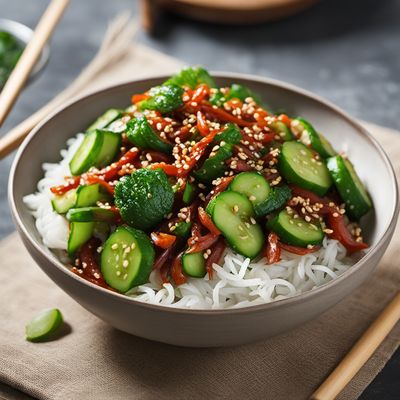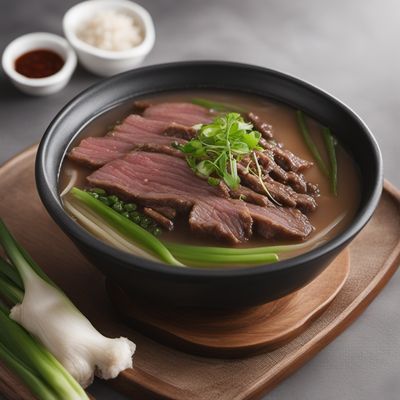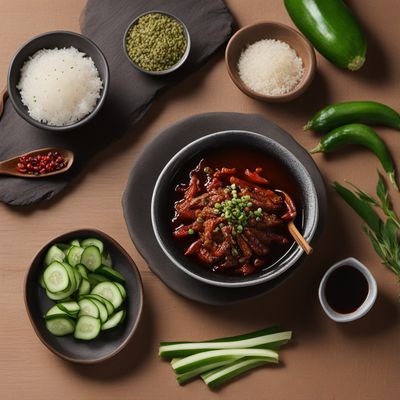
Recipe
Korean Sundae Sausage
Savory Delight: Korean Sundae Sausage with a Twist
4.4 out of 5
Indulge in the flavors of Korean cuisine with this authentic recipe for Sundae Sausage. Made with a unique combination of ingredients, this dish is a popular street food in Korea and is sure to satisfy your taste buds.
Metadata
Preparation time
30 minutes
Cooking time
30 minutes
Total time
60 minutes
Yields
4 servings
Preparation difficulty
Medium
Suitable for
Gluten-free, Dairy-free, Nut-free, Low-carb, High-protein
Allergens
Pork, Soy
Not suitable for
Vegetarian, Vegan, Paleo, Keto, Halal
Ingredients
-
500g (1.1 lb) pork blood 500g (1.1 lb) pork blood
-
100g (3.5 oz) glass noodles 100g (3.5 oz) glass noodles
-
1 cup cooked rice 1 cup cooked rice
-
1 tablespoon soy sauce 1 tablespoon soy sauce
-
1 tablespoon sesame oil 1 tablespoon sesame oil
-
1 teaspoon salt 1 teaspoon salt
-
1 teaspoon black pepper 1 teaspoon black pepper
-
1/2 teaspoon sugar 1/2 teaspoon sugar
-
1/2 teaspoon minced garlic 1/2 teaspoon minced garlic
-
1/2 teaspoon grated ginger 1/2 teaspoon grated ginger
-
Natural sausage casing Natural sausage casing
Nutrition
- Calories (kcal / KJ): 250 kcal / 1046 KJ
- Fat (total, saturated): 12g, 4g
- Carbohydrates (total, sugars): 20g, 2g
- Protein: 15g
- Fiber: 1g
- Salt: 1.5g
Preparation
-
1.Soak the glass noodles in warm water for 10 minutes, then drain and cut into small pieces.
-
2.In a large bowl, combine the pork blood, glass noodles, cooked rice, soy sauce, sesame oil, salt, black pepper, sugar, minced garlic, and grated ginger. Mix well until all the ingredients are evenly incorporated.
-
3.Rinse the natural sausage casing under cold water and soak it in warm water for 30 minutes to soften.
-
4.Stuff the sausage casing with the prepared mixture, making sure to remove any air pockets. Tie the ends of the casing securely.
-
5.Place the sausage in a steamer and steam for 30 minutes.
-
6.Remove the sausage from the steamer and let it cool slightly before slicing into bite-sized pieces.
-
7.Serve the Korean Sundae Sausage with the homemade dipping sauce.
Treat your ingredients with care...
- Pork blood — Make sure to source fresh and high-quality pork blood from a trusted butcher.
- Glass noodles — Be careful not to overcook the glass noodles as they can become mushy. Follow the package instructions for the best results.
- Natural sausage casing — Soaking the casing in warm water helps to soften it and make it easier to work with.
Tips & Tricks
- If you prefer a spicier flavor, add a pinch of chili flakes to the sausage mixture.
- Serve the Sundae Sausage with a side of kimchi for a traditional Korean accompaniment.
- If you don't have access to natural sausage casing, you can shape the mixture into patties and pan-fry them for a delicious alternative.
- Experiment with different dipping sauces such as soy sauce and vinegar or gochujang (Korean chili paste) mixed with sesame oil.
- Leftover Sundae Sausage can be refrigerated and reheated in a steamer or pan-fried for a quick and tasty meal.
Serving advice
Serve the Korean Sundae Sausage as an appetizer or as part of a larger Korean meal. Garnish with sesame seeds and chopped green onions for added flavor and visual appeal.
Presentation advice
Arrange the sliced Sundae Sausage on a platter, drizzle the dipping sauce over it, and garnish with sesame seeds and chopped green onions. Serve with a side of kimchi and steamed rice for a complete Korean dining experience.
More recipes...
For Sundae Sausage
More Korean cuisine dishes » Browse all

Jjapaguri
Jjapaguri is a Korean noodle dish that is typically served as a lunch or dinner dish. The dish is made with two types of instant noodles,...

Baji
Baji is a popular Indian snack that is crispy on the outside and soft on the inside. It is made with gram flour, spices, and vegetables. This dish...

Korean Corndog
Korean Corndog is a popular street food in South Korea that has gained popularity worldwide. It is a deep-fried hot dog coated in a layer of sweet...






